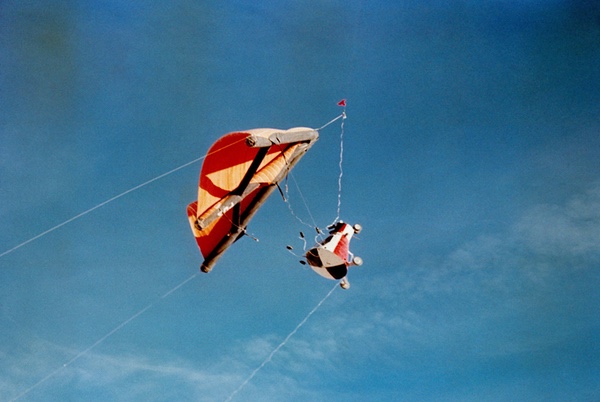Gemini’s wing and a prayer (part 3): boilerplates and El Kabongby Dwayne A. Day
|
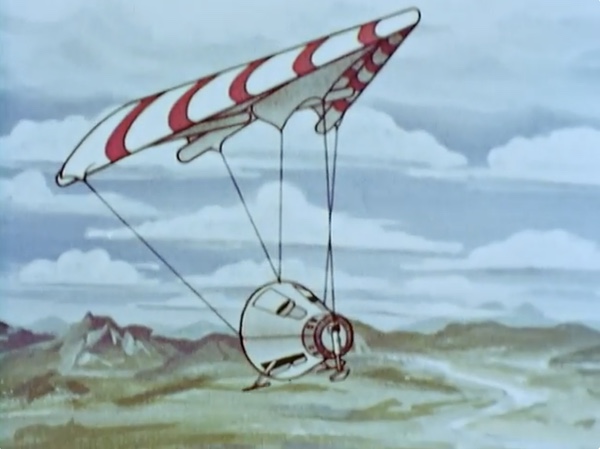 NASA produced a short animated video showing the landing of a Gemini spacecraft using a Rogallo Wing. (credit: NASA) |
Two Full Scale Test Vehicles were planned to test the spreading of the wing in flight. The FSTV would be dropped from an aircraft and test the deployment sequence, but after a glide down to 3000 meters the paraglider would be jettisoned and the FSTV would descend using the emergency parachute system. [2]
Another phase of the testing would pick up at the point where the first one ended: 3,000 meters. A manned vehicle would be towed up to 3,000 meters behind a helicopter and released to glide down to the ground in controlled flight. By splitting the testing, both the deployment phase testing and the landing phase testing could be conducted at the same time, theoretically shortening the overall testing time. [3]
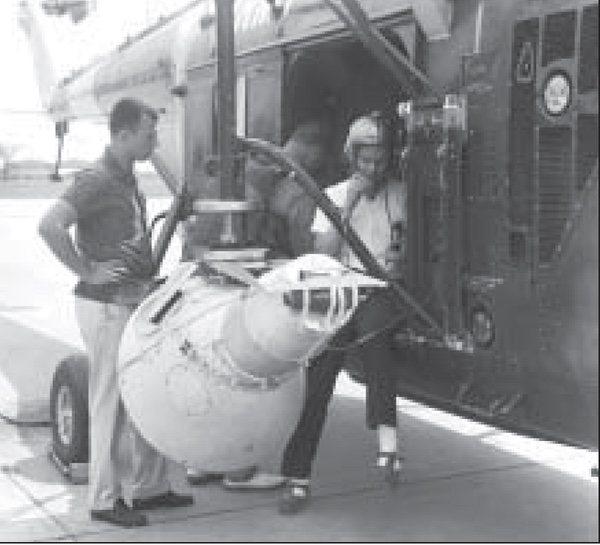 NASA conducted tests using a half-scale vehicle dropped from a helicopter. Some of these tests ended with the destruction of the vehicle. (credit: NASA) |
A half-scale boilerplate was converted to a Half Scale Tow Test Vehicle (HSTTV) to test takeoff techniques. North American was also building two vehicles: a paraglider trainer and a full-scale TTV.
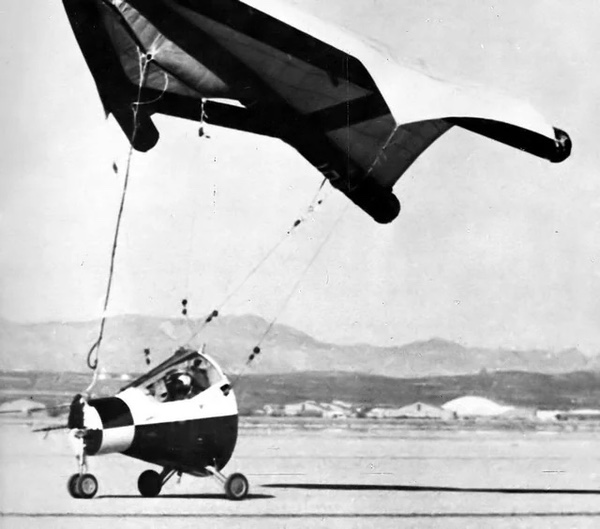 One of the two Tow Test Vehicles during a test at Edwards Air Force Base. (credit: NASA) |
On May 27, 1963, North American began testing the HSTTV. These tests were completed on July 29 and the model was then delivered to the Flight Research Center in August. The company conducted more tow tests behind an automobile, followed by helicopter tow tests. [4]
| On April 22 another test failed, prompting NASA to cancel remaining plans to use the paraglider on Gemini, making this announcement on August 10, 1964. |
On May 22 and June 3, the company conducted two tests with an unmanned boilerplate to qualify a new emergency parachute system. They then conducted several more successful tests, but on July 30 both the main and backup emergency parachutes failed and the boilerplate plummeted to the ground and was destroyed. North American was ordered to conduct more qualification tests which they did in November and December. [5]
Meanwhile, other parts of the project were progressing. From July to August, North American conducted more paraglider wind tunnel tests at Ames. Equally important, the first full-scale prototype paraglider wing was under construction in the company’s plant in Downey, California. It was finished on October 14, 1963, and then shipped to NASA’s Ames center for wind tunnel tests. But the tests dragged on into December. [6]
NASA was announcing its first crews for upcoming Gemini missions and some of them posed in their spacesuits with a model of a Gemini spacecraft equipped with landing skids, an indication the space agency still planned on using the technology.
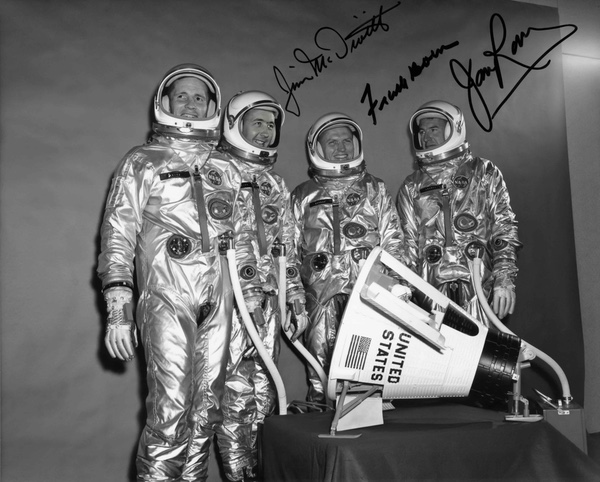 NASA took publicity photos of Gemini crews with a model of a Gemini equipped for land landing. (credit: Roger Guillemette Collection) |
Full-scale test vehicles
North American’s no. 1 Tow Test Vehicle, which had formerly been the paraglider trainer, was finished on October 25, 1963. It was shipped to the Flight Research Center which conducted preliminary ground tows. In mid-December, the two Full Scale Test Vehicles were delivered to the Flight Research Center and in mid-February the second Tow Test Vehicle arrived. North American planned to conduct 20 tests using the FSTV. On January 22, 1964, the FSTV was carried into the air in a Lockheed C-130. But the paraglider did not deploy successfully. On February 8, March 6, and April 10, more tests were conducted, but all were failures. On April 22 another test failed, prompting NASA to cancel remaining plans to use the paraglider on Gemini, making this announcement on August 10, 1964. North American could continue the test program, but there would be no operational use of the paraglider. The company began laying off 2,500 employees. [7]
NASA’s cancellation of the paraglider for Gemini was in many ways a prudent decision. The paraglider system added weight to the Gemini, both for the paraglider itself and the tricycle landing gear required to bring the craft down on its side. When the paraglider was delayed from the first flight eventually to the seventh flight and then later flights, Gemini designers used the weight margins allocated to the paraglider for other things. Some of that weight margin was used up by experiments and other equipment carried aboard the spacecraft. If the paraglider eventually flew, equipment would have to be eliminated from the spacecraft, reducing its capabilities.
NASA also had another reason for cancelling its plans for including the paraglider on Gemini: the hope that the Air Force might choose to incorporate the technology into its own version, the Gemini B then under development for the Manned Orbiting Laboratory, or MOL. If the Air Force took over development, NASA would not have to pay for it. In March 1964 NASA asked the Air Force if it had any interest in the paraglider capability. Nearly two months later the Air Force responded that the military would only consider using the paraglider after NASA had qualified and demonstrated it in its own program. [8]
The first uncrewed Gemini orbital test flight was launched on April 8, 1964. The spacecraft was intentionally destroyed during reentry.
Pilots take flight
Despite NASA’s decision to not use the paraglider on Gemini, North American continued the remaining test flights. On April 30, the FSTV was dropped and successfully deployed its paraglider. On May 29, another test was successful. But tests 8 through 22 experienced problems. The deployment sequence worked, but the vehicle would not achieve a stable glide. Three flights on October 23, November 6, and December 1 were successful. The company also began demonstrations of the landing techniques utilizing the Tow Test Vehicle.
On July 29, 1964, a helicopter towed North American pilot E.P. Hetzel into the air. The helicopter towed him around for 20 minutes and then he descended to the ground with the tow cable still attached. Hetzel made a smooth landing underneath the paraglider. [9]
On August 7, Hetzel made the first free flight. At an altitude of about 5,000 meters, he released the tow cable. But then disaster struck: the vehicle went into a tight left-hand turn and headed for the ground. At 1,000 meters Hetzel parachuted out of the craft and was slightly injured. The TTV was moderately damaged upon hitting the ground.
| During the flare maneuver, the pilot had to command the vehicle early and hopefully the wing would respond at the proper point in the descent. |
After this incident, North American conducted 14 radio-controlled flights from August to December 1964 using the half scale TTV and then two radio-controlled full-scale TTV free flights in mid-December. On December 19, the TTV was towed aloft with pilot Donald F. McCusker at the controls. The tow cable was released at about 3,000 meters and he flew to the landing area. But McCusker flared the wing late and the vehicle hit the ground hard. He was injured.
The problem, according to test pilot Milt Thompson, was determining when to make the flare maneuver. This was hard enough in the Paresev, which had good visibility and an open cockpit and a responsive control system. But the Gemini had none of these.
Instead of a wing connected directly to the frame of the vehicle, the vehicle hung underneath the wing on long cables. The cable control system meant that there was a lag between the pilot making control inputs and the wing responding to the commands. During the flare maneuver, the pilot had to command the vehicle early and hopefully the wing would respond at the proper point in the descent. [10]
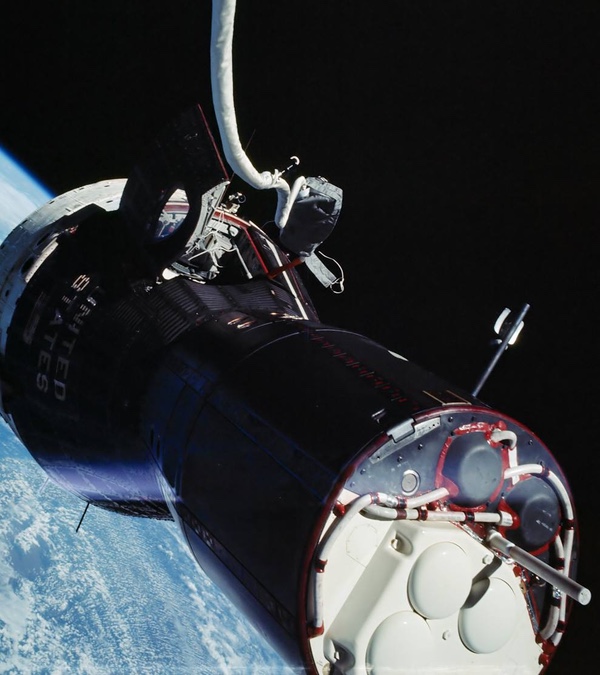 The Rogallo Wing test program moved too slow to be incorporated into Gemini. NASA launched Gemini missions at a rapid pace starting in 1965. (credit: NASA) |
Gemini flies
Gemini 3, the first mission with a crew, launched into orbit with astronauts Gus Grissom and John Young on March 23, 1965. Gemini 4 followed in June, featuring the first American spacewalk. Gemini 5 launched in August. Seven more missions flew between December 1965 and November 1966—a total of ten piloted missions in 20 months, a rapid pace with each mission making significant strides in developing new operational techniques.
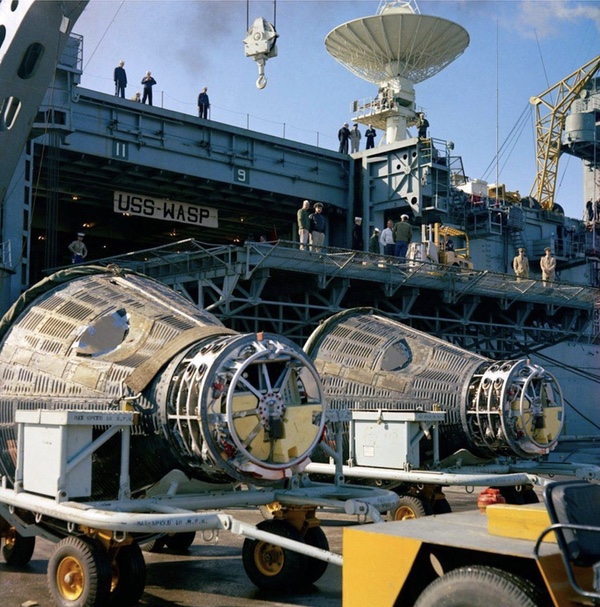 Each Gemini recovery included an aircraft carrier and multiple support ships. It was an expensive operation. (credit: NASA) |
Not every technology planned or built for Gemini flew, or worked as intended, but the program significantly advanced the state of the art and moved NASA closer to its goal of landing astronauts on the Moon. It also occurred at a time when the Soviet Union had ceased flying cosmonaut missions, resulting in the United States gaining substantially more in-orbit experience. The paraglider was not necessary for Gemini to achieve any of its primary goals.
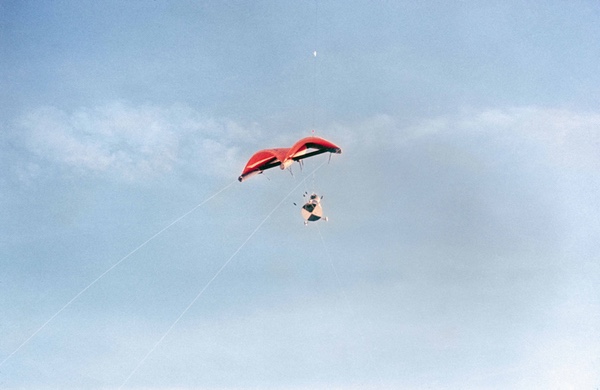 NASA had two Tow Test Vehicles for piloted tests of the Rogallo Wing. Test pilots suffered several accidents. Although they proved that it was possible to successfully land using the wing, it was a difficult system to use, in part because the cables between the vehicle and the wing meant that there was a lag between control inputs and the movement of the wing. (credit: NASA) |
Testing continues
Although it was cancelled, North American still had interest in the paraglider technology for other potential uses and, in May 1965, began a seven-month test program using hardware left over from Gemini. On September 3, 1965, McCusker was towed aloft in the TTV behind a Sikorsky S-61L helicopter and released at 2,500 meters altitude. He conducted some maneuvers and glided the vehicle to a successful landing. The company conducted 12 flights through November 1965 and demonstrated precision touchdowns. Gemini missions were by this time regularly flying in orbit and splashing down in the ocean. [11]
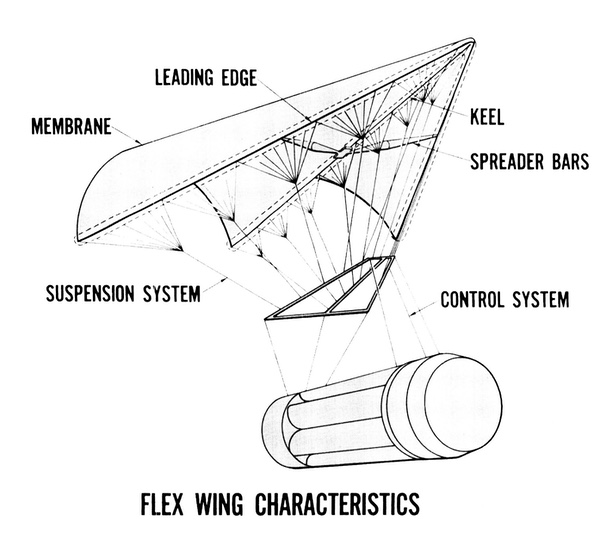 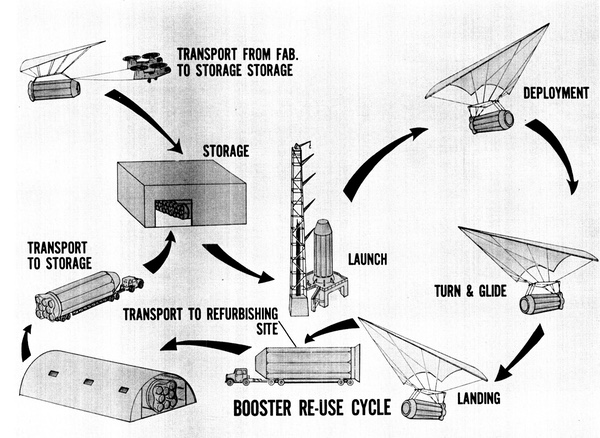 NASA considered the Rogallo Wing technology for other missions. A contractor studied its possible use for returning Saturn I rocket first stages to Earth for reuse. (credit: NASA) |
NASA produced artwork illustrating a large Saturn launch vehicle first stage descending to Earth underneath a giant paraglider. The NASA Langley Research Center did drop a small scale model of a Saturn I first stage from a helicopter to successfully test deployment of the paraglider. But the agency never seriously evaluated the paraglider for this role. [12]
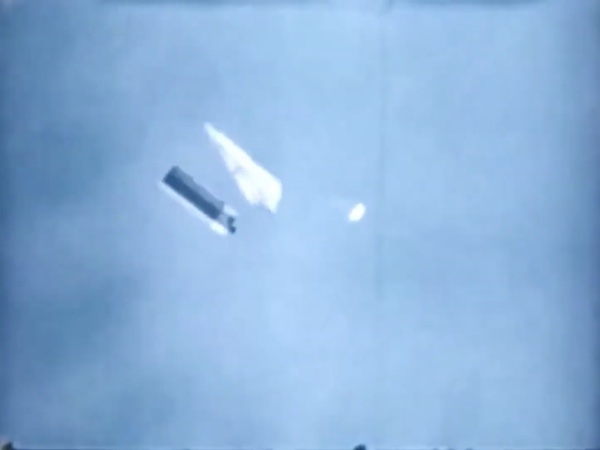 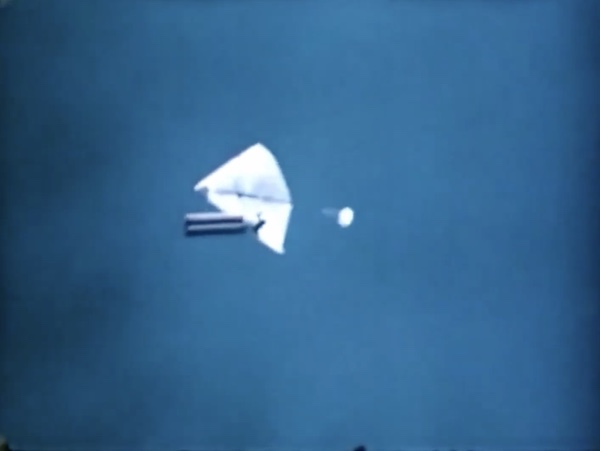 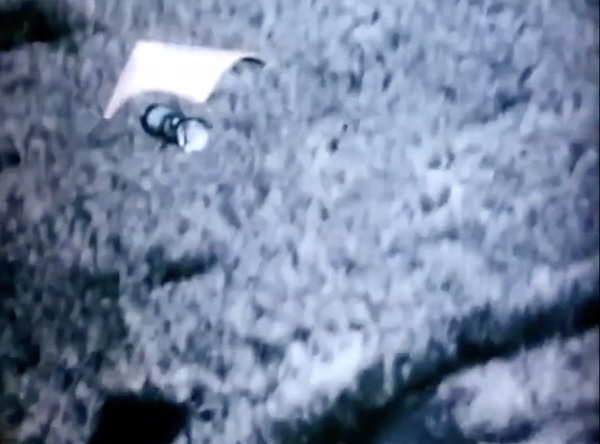 In the early 1960s, NASA conducted a test of a small model Saturn 1 rocket stage and a deployable Rogallo Wing. The model was dropped from a hovering helicopter near the Langley Research Center in Virginia. It successfully deployed the wing and floated to a relatively soft landing on the ground. (credit: NASA) |
Milton Thompson did not consider the paraglider landing system at all practical for piloted spacecraft and apparently neither did others involved in the latter tests. However, NASA’s research on the paraglider did eventually pay off in the recreational aviation world. By the early 1970s, sport enthusiasts had adapted Rogallo’s basic paraglider design into the modern-day hang glider. They initially used it while jumping off cliffs in Southern California. [13]
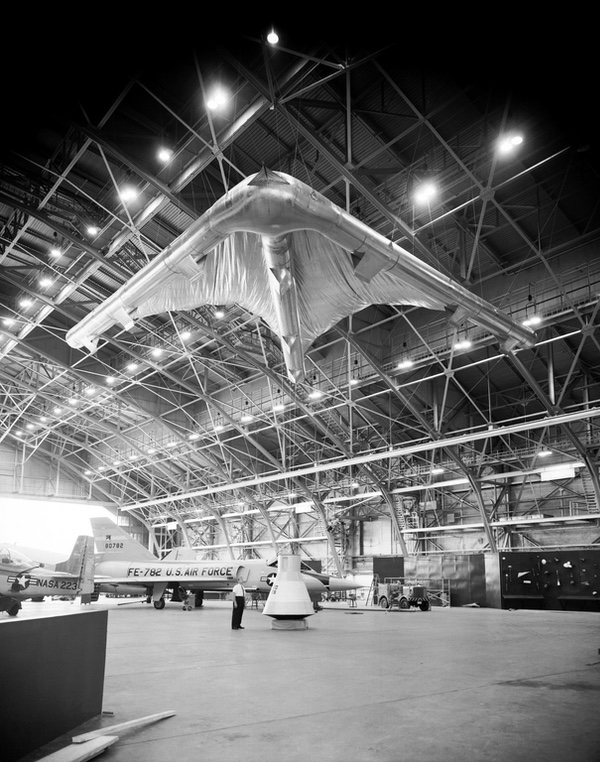 The first studies of the Rogallo Wing for landing spacecraft on land used the Mercury spacecraft, but studies soon shifted to incorporating it into the Gemini program. (credit: NASA) |
The parasail
The paraglider was not the only alternative technology for returning a ballistic re-entry type spacecraft to Earth. During the paraglider test program critics of the paraglider design suggested an alternative approach using a parasail. A parasail is a parachute that can be manipulated to provide some direction control. Compared to the paraglider, the parasail has less lift and a higher descent speed, meaning that unless additional braking is provided by descent rockets, it will hit the ground faster. Although later parasails were rectangular in shape, the early ones tested by NASA were shaped like a traditional canopy parachute, but with openings cut in one side to allow air to flow out in one direction and the capsule to fall more diagonally than vertically, with limited direction control.
But the astronauts were not happy with the parasail idea because it depended upon a system that had to work perfectly in the very last seconds of the descent. If the braking rockets failed, they would have no backup. NASA rejected the parasail proposal for Gemini. [14]
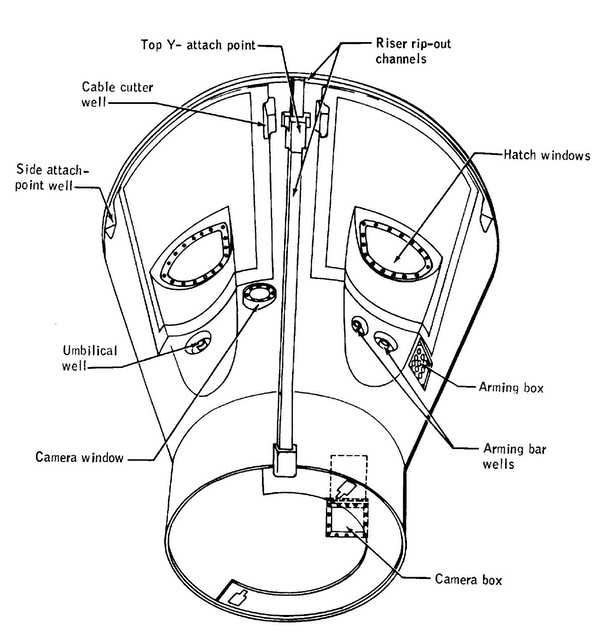 The El Kabong I vehicle was used in parasail tests after the Rogallo Wing/paraglider test program ended. (credit: NASA) |
However, although NASA rejected the parasail, the agency did conduct trials of a boilerplate Gemini spacecraft designated El Kabong I in summer 1965. The tests were conducted in Texas. The boilerplate was dropped from an aircraft and equipped with a parasail and landing rockets that fired for 0.4 seconds when the spacecraft was approximately four meters above the ground. The rockets reduced the vehicle’s forward velocity. The spacecraft skidded over 20 meters but came within 11 meters of a target marker. The parasail was developed by Pioneer Parachute Co. of Manchester, Connecticut. Although NASA had no plans for the system, the US Air Force was developing the technology for radio-controlled gliding of cargo to ground targets obscured by smoke, fog, or darkness. [15]
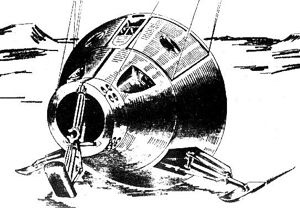 The Big Gemini proposal in the later 1960s would have used a parasail and performed a land landing. This was considered necessary because of the large crew that would be onboard. (credit: NASA) |
In the latter 1960s McDonnell sought to develop a larger version of the Gemini designated the Big Gemini or Big G. It could accommodate a crew of nine and a large supply module. An enlarged version could carry a crew of up to 12. The Big G would also use the parasail and a three-skid landing gear. The Big-G spacecraft was never approved, but the Flight Research Center conducted numerous remote-control tests in 1969 using a generic ogive lifting body shape equipped with Gemini viewing ports and dropped from a SH-3 helicopter.
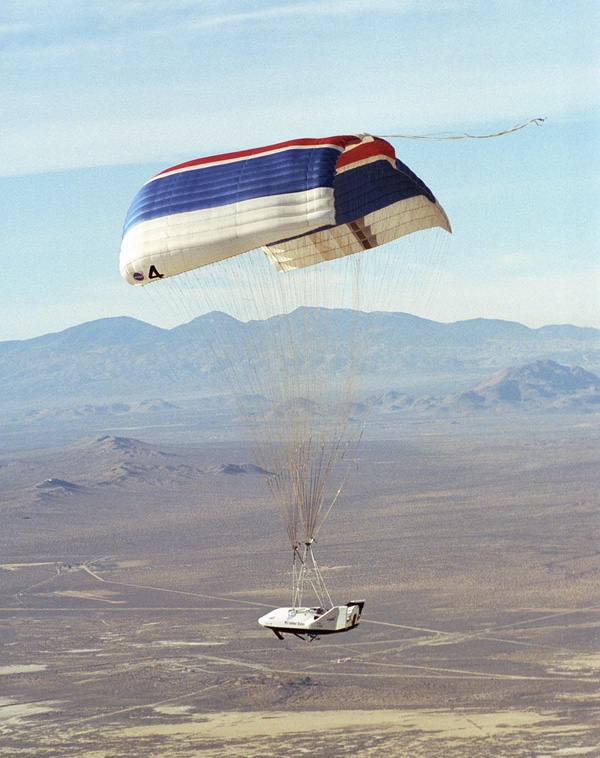 The parasail was tested by NASA in the latter 1960s and evolved for both military and civilian use. NASA considered it for the X-38 spacecraft in the 1990s. The X-38 was to serve as a rescue lifeboat for the International Space Station. (credit: NASA) |
Decades later, when NASA again began looking at methods of returning small spacecraft to Earth, the parasail idea was revived. NASA began work on the X-38 Crew Return Vehicle in the mid-1990s. The X-38 borrowed from much previous NASA research. The basic design was similar to earlier NASA lifting bodies such as the HL-10, M2- F3, and the Air Force’s X-24A. But lifting bodies had poor control characteristics at low speeds, so rather than landing it conventionally like an aircraft, the plan was to deploy a parasail and fly the craft to a slower landing underneath it. The Crew Return Vehicle was intended to serve as a lifeboat for the International Space Station. When the station ran over budget, the spacecraft was cancelled.
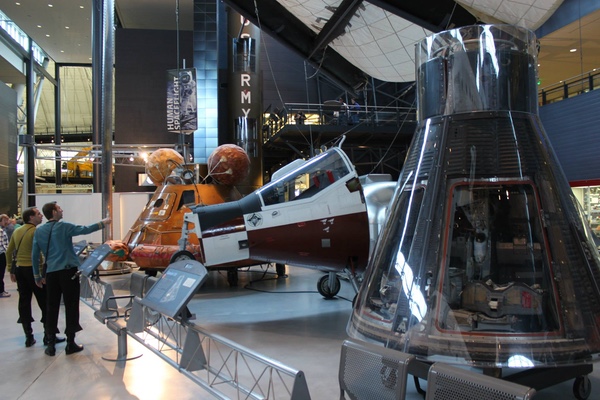 Tow Test Vehicle 1 is on display at the Smithsonian’s Udvar-Hazy Museum near Dulles International Airport. The Paresev 1-A vehicle is also on display nearby. (credit: Dwayne Day) |
Museum birds
After the paraglider program was cancelled, most of the remaining hardware was mothballed or converted to other uses for the Gemini program. The Paresev I-A was preserved and is now on display at the Smithsonian National Air and Space Museum’s Steven F. Udvar-Hazy Center near Dulles International Airport outside of Washington, DC. The Paresev hangs from the museum’s cavernous hangar, still looking as ungainly as ever.
| Perhaps the most obscure remnant of this program is the boilerplate spacecraft known as “El Kabong I” and on display in the Air Zoo Museum in Kalamazoo, Michigan. |
The Gemini Tow Test Vehicle-1, or TTV-1, is also on display at the same facility, sporting a gleaming paint job, and looking only slightly less fragile than the Paresev. It sits next to the Gemini 7 spacecraft, which at one time was scheduled to be equipped with a paraglider. Tow Test Vehicle-2 is on display at the National Space Centre, Leicester, England. [16]
But perhaps the most obscure remnant of this program is the boilerplate spacecraft known as “El Kabong I” and on display in the Air Zoo Museum in Kalamazoo, Michigan. El Kabong I was one of the Full Scale Test Vehicles equipped with landing gear and dropped from aircraft to test paraglider deployment and later used in the August 1965 parasail test with the landing rocket system. The vehicle obtained its unusual name from a 1960 cartoon called “El Kabong!” about the Zorro-like alter-ego of cartoon dog Quick Draw McGraw. [17]
According to Stewart Bailey, a former Air Zoo official, the boilerplate capsule had previously been located at the now-closed Michigan Space and Science Center in Jackson, Michigan. Jackson was home to astronauts Jim McDivitt and Al Worden, as well as the birthplace of Captain Bob Freitag, one of NASA’s deputy administrators for advanced projects. The museum was on the campus of Jackson Community College, which counted McDivitt among its graduates.
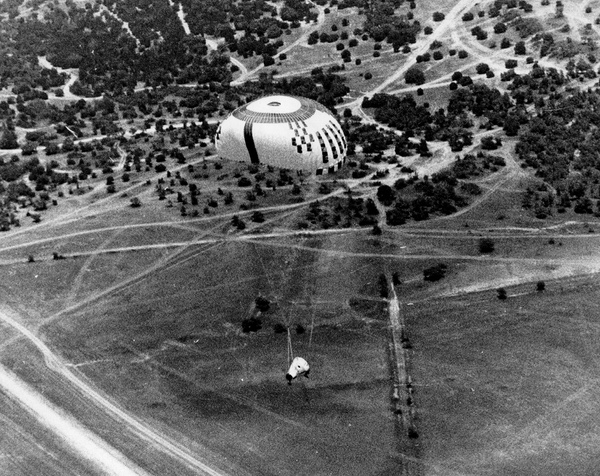 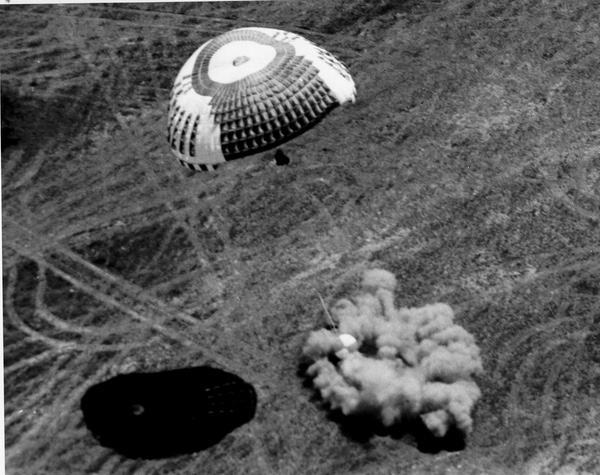 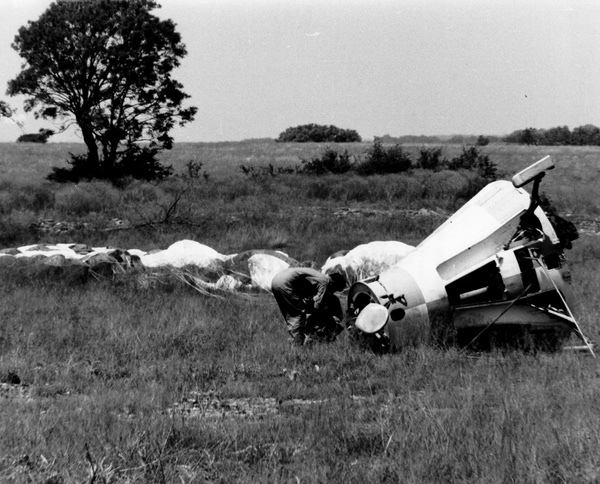 After finishing the Gemini paraglider tests in California, NASA began a series of tests of a parasail using a Gemini boilerplate named El Kabong I. These tests were unpiloted. The early parasail was a canopy parachute vented on one side. The vehicle also had two solid rocket motors mounted underneath to fire just before touchdown to reduce the velocity. El Kabong I survived the testing program and is currently on display in Michigan. (credit: NASA) |
“El Kabong came to the Air Zoo in December of 2001 after being in storage in Jackson,” Bailey explained. The artifact officially belongs to the Smithsonian National Air and Space Museum and Bailey believes that it went to Jackson around 1977 when the museum received several other Smithsonian artifacts. “It sat for a number of years out-of-doors until its condition degraded to the point where it was placed in a warehouse in downtown Jackson by the director who was my predecessor.”
El Kabong was in extremely bad shape by the latter 1990s, as demonstrated by photographs taken prior to and during the restoration process. The metal was rusted through in numerous places and its paint had faded and chipped. The Smithsonian wanted the Space Center to return the capsule because it was not on public display. But the museum instead brokered a deal where the Air Zoo was able to obtain it from Jackson. The Air Zoo then began to restore it. “The restoration process was rather extensive and took place from 2002 through 2004, with it going on display in the new Air Zoo building in October 2004,” Bailey added.
As can be seen in restoration photographs, the artifact was stripped down to bare metal and treated for corrosion. Holes and other damage were repaired. It was then repainted in the white and orange high visibility color scheme that it wore in the 1960s. It now sits in the Air Zoo, on display alongside numerous aircraft including an F-14 Tomcat, an F-18 Hornet, and an AH-1 Cobra attack helicopter.
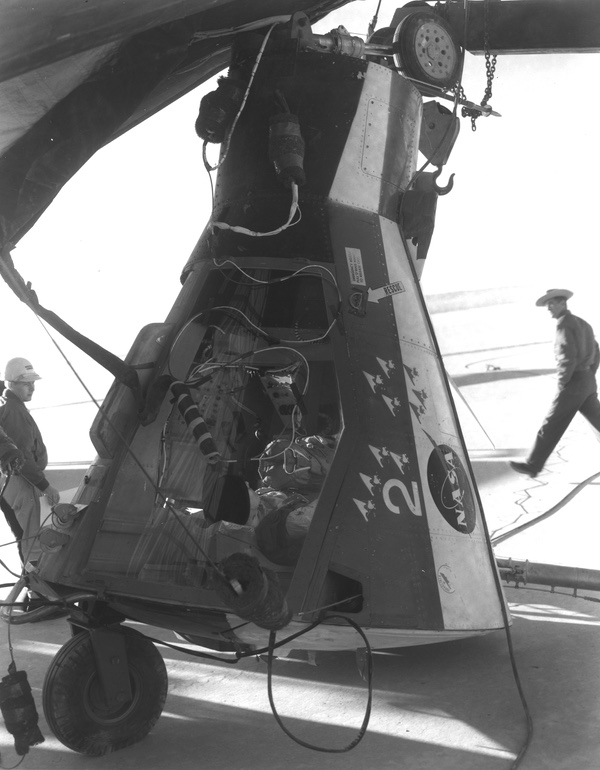 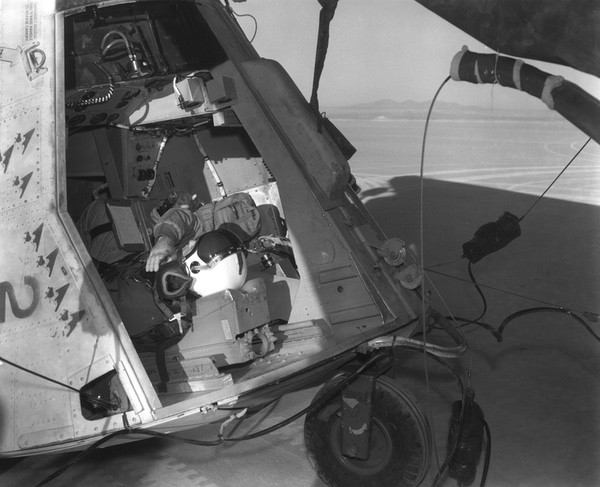 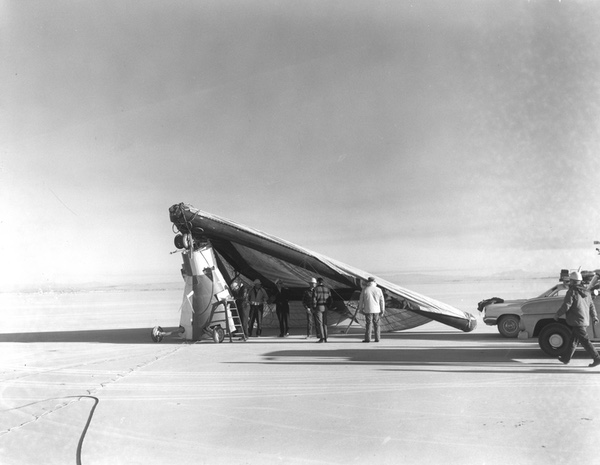 Tow Test Vehicle 2 during a test at Edwards Air Force Base. It appears that a dummy is installed in the vehicle rather than a pilot. This vehicle survived the testing program and is on display in the United Kingdom. (credit: NASA) |
A finicky technology
Re-entering the Earth’s atmosphere from space has always been a challenge for spacecraft designers. NASA and the Air Force explored several controlled reentry vehicle techniques. The Air Force tested the PRIME vehicle as a means of achieving precision reentry. NASA tested numerous lifting body vehicles such as the M2-F2, M2-F3, and the HL-10. (See “Movements of fire and shadow: The X-23 PRIME reentry vehicle and American satellite reconnaissance,” The Space Review, March 5, 2018.) All of these technologies had severe limitations, particularly controllability.
Could the paraglider have been made to work if it had more time? The paraglider at first seemed like a promising technology that could solve the problem of bringing a spacecraft down to a specific area and placing it gently on the ground. But the technology never fully matured, despite considerable time and effort spent by NASA to perfect it. It seems doubtful that NASA engineers would have grown comfortable enough with the technology to use it when astronauts’ lives were at risk.
Barton C. Hacker, who co-wrote several valuable histories of the Gemini program, noted that the first Gemini program director was enamored of the paraglider technology and wanted to include it in the program. However, when he left, his successor was more pragmatic and was only willing to use it if the technology could be reliably proven by a clear deadline. When that became impossible, he deleted it from the Gemini program and it became an R&D program only. Hacker suggests that rather than a clear response to a requirement to reduce the costs of the recovery effort by eliminating the recovery ships, the paraglider was more the result of the willingness of a key NASA official to include it in his program. [18]
Although the test program failed to produce an operational technology for Gemini, the test program itself should not be considered a failure. It explored the limitations of the technology for spacecraft use. Paragliders were fine for recreational sport, but for they did not have to be deployed in flight and could use metal struts to hold them in place. The spacecraft version used inflatable struts that had to be deployed while a heavy spacecraft was falling through the upper atmosphere, and the wing had to be controlled by a pilot with limited visibility.
Even if the Gemini paraglider program had been better managed from the beginning with fewer quality control problems, the five decades since that time have demonstrated that the paraglider concept is not reliable or predictable enough for high value missions where lives are at stake.
But it would have been cool.
Note for non-American readers: Quick Draw McGraw is a relatively obscure cultural reference for Americans today, and El Kabong! is extremely obscure, although he would have been better known to people back in the early 1960s.
Author’s Note: This series is a revised version of a two-part article the author originally wrote for Spaceflight magazine in August and September 2007.
- James M. Grimwood, Barton C. Hacker, and Peter Z. Vorzimmer, Project Gemini: A Chronology, NASA, 1969, pp.89-90; “Compilation of Papers Presented to Meeting on Space Vehicle Landing and Recovery Research and Technology,” NASA Headquarters, July 11, 1962
- Barton C. Hacker and James M. Grimwood, On the Shoulders of Titans, NASA, 1977, p.133.
- Ibid., p.133.
- Ibid., p.144.
- Ibid., pp.144-146.
- Ibid., p.148; Ibid., Project Gemini: A Chronology, p.104; 118-119; 122.
- Ibid., pp.92-93; 120.
- Ibid., p.130.
- On the Shoulders of Titans, p.170; Project Gemini: A Chronology, p.135.
- On the Shoulders of Titans, p.171.
- Ibid, p.172; Project Gemini: A Chronology, p.168.
- Ryan, “Paraglider Recovery System for the Saturn Booster,” August 15, 1961.
- On the Shoulders of Titans, p.171;
- “NASA Tests Para-Sail, Landing Rocket System,” Aviation Week & Space Technology, August 30, 1965, p.54.
- On the Shoulders of Titans, p.172; Leland C. Norman, Jerry E. McCullough, and Jerry C. Coffey, NASA Manned Spacecraft Center, “Gemini Land Landing System Development Program,” Vol. 1 – Full-Scale Investigations, March 1967.
- M. O. Thompson and C. Peebles, Flying Without Wings, p.204; R. Dale Reed, Wingless Flight: The Lifting Body Story, NASA, 1997, pp.159-161.
- On the Shoulders of Titans, p.89; “NASA Tests Para-Sail, Landing Rocket System,” Aviation Week & Space Technology, August 30, 1965, p.54.
- Barton C. Hacker, “The Failure of the Gemini Paraglider,” Revised version of I.A.S. Paper 74-23 presented at the 8th History Symposium, Fifth Congress of the International Astronautical Federation, 1974.
Note: we are now moderating comments. There will be a delay in posting comments and no guarantee that all submitted comments will be posted.
